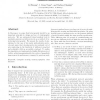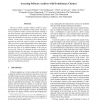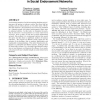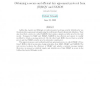255 search results - page 21 / 51 » Principles for Entity Authentication |
IJNSEC
2007
13 years 7 months ago
2007
In this paper, we argue that heterogeneity should be an important principle in design and use of cryptographic protocols. We use automated formal analysis tools to randomly genera...
IWPC
2008
IEEE
14 years 1 months ago
2008
IEEE
The way in which a system’s software archive is partitioned influences the evolvability of that system. The partition of a software archive is mostly assessed by looking at the...
LREC
2010
13 years 8 months ago
2010
The Semantic Web is facing the important challenge to maintain its promise of a real world-wide graph of interconnected resources. Unfortunately, while URIs almost guarantee a dir...
RECSYS
2010
ACM
13 years 7 months ago
2010
ACM
An increasing number of social networking platforms are giving users the option to endorse entities that they find appealing, such as videos, photos, or even other users. We defin...
DCC
2008
IEEE
14 years 7 months ago
2008
IEEE
LaMacchia, Lauter and Mityagin recently presented a strong security definition for authenticated key agreement strengthening the well-known Canetti-Krawczyk definition. They also ...




